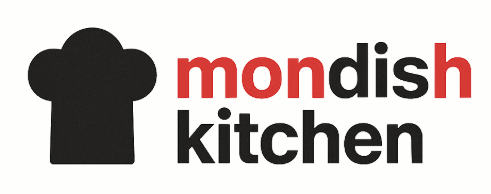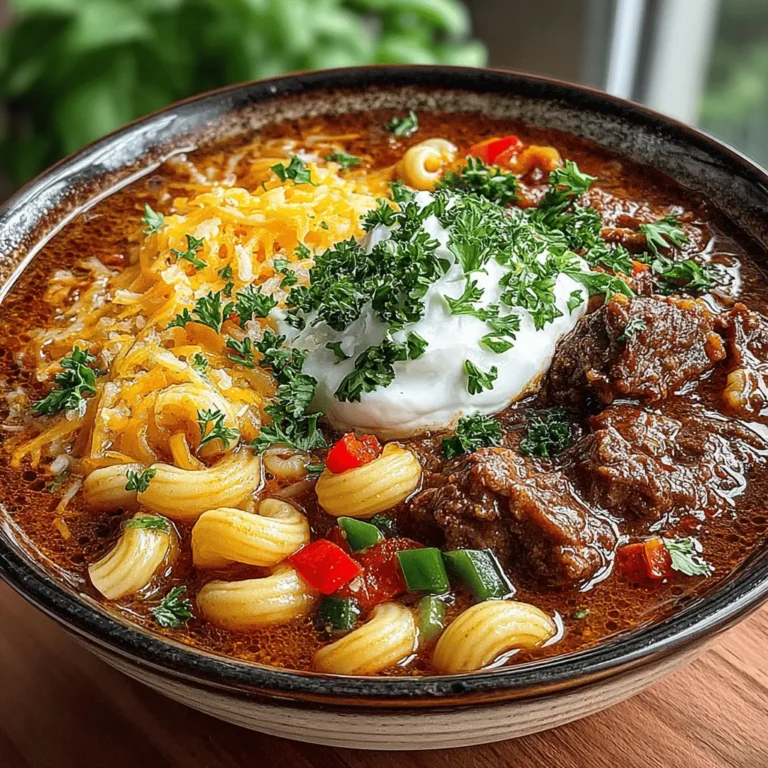Comforting Slow-Cooked Goulash: A Heartwarming Dish for Any Occasion
Goulash is more than just a meal; it’s a warm embrace on a chilly day, a nostalgic taste of home, and a dish that brings families together. Originating in Hungary, this hearty stew has transcended borders and evolved into various interpretations worldwide, but the essence remains the same: a comforting blend of meat, vegetables, and spices that warms the soul. In our fast-paced lives, slow-cooked meals like goulash offer a perfect solution for busy individuals and families, allowing them to enjoy a delicious, home-cooked meal without spending hours in the kitchen.
Slow cooking not only simplifies meal preparation but also enhances the flavors of the ingredients, allowing them to meld beautifully over time. With the right combination of wholesome ingredients, you can create a nourishing dish that caters to both taste and health. Let’s dive deeper into what makes goulash such a beloved comfort food and explore how you can prepare this inviting dish at home.
Understanding Goulash: A Comfort Food Classic
Goulash has a rich history that dates back to the 9th century when Magyar shepherds prepared a simple stew of meat and vegetables in a cauldron over an open fire. This humble dish, known as “gulyás,” which translates to “herdsman,” became a staple for Hungarian cattlemen. Over the centuries, goulash evolved as it traveled across Europe, adopting unique ingredients and cooking methods in different cultures.
In Austria, for instance, goulash is often thickened with a roux, while in Germany, it may include a wider variety of vegetables. In the United States, goulash is often associated with a comforting one-pot meal of pasta, meat, and tomato sauce, demonstrating its adaptability to local tastes. Despite these variations, the core of goulash remains: it is a dish that signifies warmth, community, and shared meals.
Family gatherings often feature goulash as a centerpiece, bringing people together around the table. Its robust flavors and satisfying ingredients make it an ideal choice for potlucks, holidays, or simply a cozy dinner at home. Whether enjoyed on a cold winter night or during a summer barbecue, goulash evokes feelings of comfort and nostalgia, making it a timeless classic.
Ingredient Breakdown
To create your own comforting slow-cooked goulash, you’ll need a selection of key ingredients that not only contribute to the dish’s rich flavor but also provide a range of nutritional benefits. Here’s a closer look at the primary components:
1. Beef: The traditional choice for goulash is beef, often in the form of chuck roast or stew meat. It is a great source of protein, iron, and essential B vitamins, making it a hearty base for the dish. If you prefer a leaner option, consider using ground turkey or chicken.
2. Onions and Garlic: These aromatic vegetables are foundational to goulash, delivering depth and richness. Onions provide antioxidants and essential nutrients, while garlic adds flavor and potential health benefits, including immune support.
3. Bell Peppers: These vibrant vegetables add sweetness and color to the dish. Rich in vitamins A and C, bell peppers also provide fiber, enhancing the nutritional profile of your goulash.
4. Tomatoes: Whether using canned diced tomatoes or tomato paste, tomatoes add acidity and a rich flavor to the stew. They are also a great source of lycopene, an antioxidant linked to numerous health benefits.
5. Paprika: A hallmark of goulash, paprika brings warmth and earthiness to the dish. Its distinct flavor is essential for achieving that authentic goulash taste. Plus, it contains capsaicin, which may have anti-inflammatory properties.
6. Herbs and Spices: A blend of herbs such as bay leaves, thyme, and parsley, along with seasoning like salt and pepper, rounds out the flavor profile of goulash, making it aromatic and inviting.
7. Broth: Beef or vegetable broth forms the base of the sauce, infusing the dish with moisture and flavor. Low-sodium options can help control salt intake while still delivering great taste.
For those with dietary preferences or restrictions, there are alternatives available. Ground turkey or chicken can replace beef for a leaner option, while lentils or mushrooms can serve as a hearty vegetarian substitute. Additionally, gluten-free pasta can be used if you’re adapting the dish to accommodate gluten sensitivities.
Step-by-Step Cooking Process
Now that we have a solid understanding of the ingredients, let’s walk through the initial steps of preparing your slow-cooked goulash.
1. Browning the Meat: Start by heating a tablespoon of oil in a large skillet over medium-high heat. Once the oil is hot, add your beef, seasoning it with salt and pepper. Sear the meat until it develops a rich brown crust on all sides. This step is crucial as it enhances the flavor through the Maillard reaction, creating a deeper taste in your goulash.
2. Sautéing the Vegetables: After browning the meat, remove it from the skillet and set it aside. In the same skillet, add diced onions and minced garlic, cooking until the onions become translucent and fragrant. This step not only softens the vegetables but also allows the flavors to develop before they are added to the slow cooker.
3. Combining Ingredients: Once the onions and garlic are ready, transfer them to the slow cooker along with the browned meat. Next, add chopped bell peppers, canned tomatoes, broth, and your chosen spices. Stir everything together, ensuring that the meat and vegetables are evenly coated in the liquids and seasonings.
4. Slow Cooking: Set your slow cooker to low and allow the goulash to simmer for 6 to 8 hours or on high for 3 to 4 hours. This long cooking time will allow the flavors to meld beautifully, resulting in a rich and hearty stew that will fill your home with the irresistible aroma of comfort food.
As you prepare your slow-cooked goulash, remember that the beauty of this dish lies in its versatility. Feel free to adjust the vegetables and spices according to your taste preferences or what you have on hand. The slow cooker will work its magic, transforming simple ingredients into a memorable meal that can be enjoyed any time of year.
{{image_2}}
The Magic of Slow Cooking
Slow cooking is a culinary technique that transcends mere convenience; it is an art form that enhances flavors and textures in ways that traditional cooking methods simply cannot replicate. When it comes to goulash, this method is particularly effective. The extended cooking time allows the ingredients to meld beautifully, resulting in a rich, complex flavor profile. The slow simmering process breaks down tougher cuts of meat, rendering them tender and juicy while allowing the spices and seasonings to infuse throughout the dish.
Using a Crockpot for your goulash not only simplifies the cooking process but also ensures a consistently superb result. Unlike stovetop cooking, where temperature control can be tricky, a Crockpot maintains a steady low heat. This gentle cooking environment enables the tastes to develop fully and ensures that everything cooks evenly, giving you a delicious meal with minimal effort.
Time Management: Low vs. High Settings
When preparing goulash in a slow cooker, you’ll often have the option to choose between low and high settings. Cooking on low typically takes about 6 to 8 hours, while the high setting will reduce the time to around 3 to 4 hours. If you’re planning your day, cooking on low is ideal for a hands-off approach, allowing you to set it and forget it until dinner time. Conversely, if you’re short on time but still crave that comforting goulash, the high setting will still yield a delicious result without sacrificing flavor.
Serving Suggestions
Once your slow-cooked goulash is ready, it’s time to serve and enjoy! Here are some ideas to elevate your goulash experience:
Garnishing Ideas
Garnishing can add a touch of sophistication and enhance the dish visually. Consider topping your goulash with shredded cheese, such as cheddar or Monterey Jack, which melts beautifully and adds creaminess. Freshly chopped parsley or chives can also brighten up the dish with their vibrant color and fresh flavor. A dollop of sour cream can provide a tangy contrast, making each bite delightful.
Side Dishes That Complement Goulash
To create a well-rounded meal, pair your goulash with complementary side dishes. Here are a few suggestions:
– Crusty Bread or Dinner Rolls: A warm, crusty loaf or soft dinner rolls are perfect for mopping up the rich sauce of your goulash.
– Green Salad: A simple green salad with a light vinaigrette adds freshness and balances the hearty goulash.
– Roasted Vegetables: Seasonal roasted vegetables, such as carrots, zucchini, or Brussels sprouts, provide additional texture and flavor.
Presentation Tips for Gatherings
When serving goulash at gatherings, presentation matters. Serve it in a large, attractive serving bowl to encourage sharing, and consider using a ladle for easy serving. Adding garnishes right before serving can make the dish look more inviting. You can also set up a “garnish station” where guests can customize their portions with their preferred toppings.
Storing and Reheating Goulash
Goulash is an excellent dish for meal prep, as it stores and reheats beautifully. However, proper storage techniques are essential to maintain its flavor and texture.
Best Practices for Storing Leftovers
After enjoying your delicious goulash, allow any leftovers to cool completely at room temperature. Transfer the goulash to an airtight container and store it in the refrigerator. Properly stored, goulash will last for about 3 to 4 days in the fridge. If you want to keep it longer, consider freezing portions for later enjoyment.
How to Properly Reheat Goulash
When it comes time to enjoy your leftovers, reheating goulash requires a gentle approach to preserve its flavor and texture. You can reheat it on the stovetop over low heat, stirring occasionally to ensure even warming. If the sauce has thickened, add a splash of broth or water to loosen it up. Alternatively, you can reheat individual portions in the microwave, covered, for about 1 to 2 minutes, stirring halfway through.
Freezing Options for Meal Prep
If you plan to freeze goulash, divide it into single-serving portions using freezer-safe containers or resealable bags. Make sure to label each container with the date and contents. Goulash can be frozen for up to 3 months. When you’re ready to eat, thaw it in the refrigerator overnight before reheating.
Nutritional Information
Understanding the nutritional content of your meals can help you make informed choices, especially when preparing comforting dishes like goulash.
Overview of Nutritional Content Per Serving
A typical serving of slow-cooked goulash (about 1 cup) contains approximately:
– Calories: 300-400
– Protein: 20-25 grams
– Carbohydrates: 30-35 grams
– Fat: 10-15 grams
These values can vary based on the specific ingredients and portion sizes used.
Healthier Modifications for Calorie-Conscious Individuals
If you’re looking to lighten up your goulash while maintaining its comforting qualities, consider the following modifications:
– Lean Meat: Opt for lean cuts of beef or turkey instead of higher-fat options. Ground turkey or chicken can also be a healthier alternative.
– Vegetable Variety: Increase the amount of vegetables in your goulash, such as bell peppers, carrots, and spinach, to add fiber and nutrients without significantly increasing calories.
– Whole Grain Pasta: If you’re adding pasta to your goulash, choose whole-grain varieties for added fiber and nutrition.
Conclusion
Slow-cooked goulash is more than just a meal; it embodies comfort and warmth, making it perfect for family dinners or gatherings with friends. The rich flavors developed through slow cooking, combined with the tender texture of the meat and vegetables, create a dish that is truly satisfying.
Don’t hesitate to experiment with the recipe to personalize it to your taste! Whether you prefer adding a bit more spice, trying different vegetables, or incorporating your favorite garnishes, the beauty of goulash lies in its versatility.
Finally, embrace the joy of sharing homemade meals with your loved ones. There’s something special about gathering around the table to enjoy a hearty, slow-cooked meal that not only nourishes the body but also warms the soul. Enjoy your cooking adventure!


